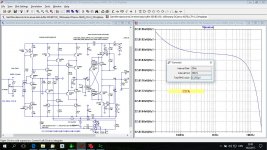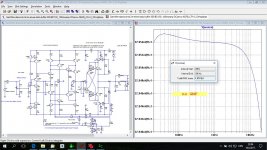Sorry, I missed that. If you refer to audio AC applications, then I 1000% agree. There's nothing special that can't be achieved with either "CFA" or "VFA".
Only that CFAs sound better, according to some TTYH experts. That CFAs (and in particular the Alexander amp) were chastised a few years ago as having a "horrible screechy sound" is of course irrelevant.
Only that CFAs somehow provide "a constant loop gain" across the audio band, according to some other experts, like that would ever matter.
Only that CFAs somehow allow more loop gain, therefore improving the distortion numbers over a VFA, according to yet other experts.
Only that CFAs potential mega slew rates are improving the sound, according to the golden ear brigade experts.
Only... for all of the above and more fetish stories, links are available upon request. The diyaudio search engine could also help.
Keep the replies coming, it will ease the search work.
The so-called current-feedback operational amplifier-technological breakthrough or engineering curiosity?
I don't have access but fun title from the 90's
The so-called current-feedback operational amplifier-technological breakthrough or engineering curiosity? - IEEE Xplore Document
I don't have access but fun title from the 90's
The so-called current-feedback operational amplifier-technological breakthrough or engineering curiosity? - IEEE Xplore Document
The so-called current-feedback operational amplifier-technological breakthrough or engineering curiosity?
I don't have access but fun title from the 90's
The so-called current-feedback operational amplifier-technological breakthrough or engineering curiosity? - IEEE Xplore Document
by
D.F. Bowers
Analog Devices Inc.
Santa Clara, CA, USA
I said save noise two days ago. I thought we were talking PA's for line stages and pre-amps CFA's are silly.
Now I have a question.
It's quite easy to make pre amp using current conveyor and make it to work in two different mode NGNF or CFA with the equal gain.
Which one has lower noise?
Now I have a question.
It's quite easy to make pre amp using current conveyor and make it to work in two different mode NGNF or CFA with the equal gain.
Which one has lower noise?
What's NGNF, no gain no feedback?
Now I have a question.
It's quite easy to make pre amp using current conveyor and make it to work in two different mode NGNF or CFA with the equal gain.
Which one has lower noise?
Noise has nothing to do with feedback. Negative feedback does not modify the open loop amplifier noise performance when the loop is closed.
The input referred voltage noise (which is one way to characterize the noise performance) depends only on the amplifier topology and devices noise properties (like the bipolar Rbb). As I already mentioned, the standard CFA topology with an input diamond buffer has worse voltage noise performance since it employs an input stage, with the usual noise, but no voltage gain.
The current noise density is either almost zero (for a jfet input stage) or depends on the bipolar base current as SQRT(2*q*Ib). Once again, nothing to do with the negative feedback. Note that a diamond buffer does not cancel the input current noise, since the noise sources (the two pnp/npn transistors) are uncorrelated. Even if the DC base currents may cancel out, the noise is still adding up.
These are all first order effects, of course. The feedback resistor to the ground may contribute to the noise. But nobody is disallowing a VFA to use arbitrary low feedback resistors, as low as in a CFA, assuming the output current supports them.
Last edited:
What's NGNF, no gain no feedback?
No Global Negative Feedback, but with gain in this case.
What's NGNF, no gain no feedback?
Negative Global Negative Feedback
Noise has nothing to do with feedback. Negative feedback does not modify the open loop amplifier noise performance when the loop is closed.
The input referred voltage noise (which is one way to characterize the noise performance) depends only on the amplifier topology and devices noise properties (like the bipolar Rbb). As I already mentioned, the standard CFA topology with an input diamond buffer has worse voltage noise performance since it employs an input stage, with the usual noise, but no voltage gain.
The current noise density is either almost zero (for a jfet input stage) or depends on the bipolar base current as SQRT(2*q*Ib). Once again, nothing to do with the negative feedback. Note that a diamond buffer does not cancel the input current noise, since the noise sources (the two pnp/npn transistors) are uncorrelated. Even if the DC base currents may cancel out, the noise is still adding up.
These are all first order effects, of course. The feedback resistor to the ground may contribute to the noise. But nobody is disallowing a VFA to use arbitrary low feedback resistors, as low as in a CFA, assuming the output current supports them.
I simulated those two cases with the same pre amp and get lower noise with pre amp in CFA. The gain in both cases set to 11dB(3.5 times).
Does that mean Ltspice simulation did it wrongly, or don't know how to simulate it?
Attachments
I simulated those two cases with the same pre amp and get lower noise with pre amp in CFA. The gain in both cases set to 11dB(3.5 times).
Does that mean Ltspice simulation did it wrongly, or don't know how to simulate it?
No idea what you are doing there, but without devices with well modelled noise sources (mostly Rbb for bipolars) noise simulation is a waste of time.
I s
Does that mean Ltspice simulation did it wrongly, or don't know how to simulate it?
I guess you should write "or I don't know how to simulate it"
I guess you should write "or I don't know how to simulate it"
Thanks, typing error.
The so-called current-feedback operational amplifier-technological breakthrough or engineering curiosity?
I don't have access but fun title from the 90's
The so-called current-feedback operational amplifier-technological breakthrough or engineering curiosity? - IEEE Xplore Document
Nothings changed. Emotive subject even in the academic journals.
No idea what you are doing there, but without devices with well modelled noise sources (mostly Rbb for bipolars) noise simulation is a waste of time.
I am using Cordell modes and there is Rb defined.
I thought I found mistake in my simulation, unequal -in resistor to the ground, but after setting to be equal to that used in CFA mode I still get higher noise in NGNF(no global no feedback - ha,ha).
I am using Cordell modes and there is Rb defined.
I thought I found mistake in my simulation, unequal -in resistor to the ground, but after setting to be equal to that used in CFA mode I still get higher noise in NGNF(no global no feedback - ha,ha).
Sorry, I'm totally agnostic of LTSpice, but may I suggest trying on a simple example and see if your simulation method is sound? Something that could be checked against a simple circuit inspection would be great. Going directly to simulating that monster is not helpful.
There is one case that I am aware of, where feedback may indirectly help with noise, is called feed forward noise cancellation: Feedforward noise cancellation rejects supply noise | EE Times More based on the same principle may be out there.
I am using Cordell modes
I don't use LTspice, but I think it's a mystery that a circuit at all could be simulated and working before Bob C. came up with the Cordell models.
I don't think that even the amplifiers in his book do work as expected with his own models.
It's funny that everybody relies on the so called Cordell models.
Cheers
S
Last edited:
No Global Negative Feedback, but with gain in this case.
First thing I don't see any effort at optimization. My SPICE will list in order all noise sources down to elements inside the model. So you need to decide what matters if just gain and noise you need to attack the top sources of noise.
The current noise of the Ie of the input devices not Ib flows (guess where for a CFA) in the feedback network. So at low gains this can be problematic.
- Home
- Amplifiers
- Solid State
- Current Feedback Amplifiers, not only a semantic problem?

